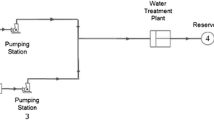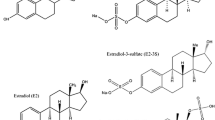Abstract
Endocrine-disrupting chemicals can produce effects on the human health or living beings. Hence, it is of high importance to determine their presence in water. This work presents a reliable method for determining 17β-Estradiol (E2) and 17α-Ethinylestradiol (EE2) in tap and drinking water. The analytic method proposed was optimized by spiking ultrapure water samples with a known amount of steroids in terms of solid phase extraction by varying elution solvent volume and analyte mass in the cartridge, the extract concentration by using either distinct temperatures in rotary evaporator or nitrogen gentle stream, and the solvent effect in chemical derivatization with N,O-bis (trimethylsilyl) trifluoroacetamide:trimethylchlorosilane (1%). The performance of the analytical method was assessed and applied to real samples; the efficiency of extraction and derivatization procedure ranged from 81 to 100% for E2 (CV 4–19%) and from 82 to 96% for EE2 (CV 4–18%). Limits of detection (quantification) were 1.0 (3.0) ng/L and 3.0 (10.0) ng/L for E2 and EE2, respectively. Analysis of the drinking water samples yielded concentrations ranging from 3.0 to 11.4 ng/L for E2 and from 10.0 to 246 ng/L for EE2. Analyses of steroids in tap water were found below the limit of detection. Consumption of drinking water in the presence of endocrine-disrupting chemicals could be a risk for the users in the long term and their consumption should be avoided under the principle of prevention.



Similar content being viewed by others
References
Barceló D, Petrovic M (2008) Emerging contaminants in waste waters: sources and occurrence. Emerging contaminants from industrial and municipal waste: removal technology. Springer, Berlin, pp 1–35
Bergman Å, Heindel JJ, Jobling S, Kidd KA, Zoeller RT (2013) State of the science of endocrine disrupting chemicals-2012. United Nations Environment Programme-WHO, Switzerland p. 296. http://www.who.int/ceh/publications/endocrine/en/. Accessed 20 Mar 2017
Bila D, Dezotti M (2007) Desreguladores endócrinos no meio ambiente: efeitos e conseqüências. Quim Nova 30:651–666. doi:10.1590/S0100-40422007000300027
Brian JV, Harris CA, Scholze M, Backhaus T, Booy P, Lamoree M et al (2005) Accurate prediction of the response of freshwater fish to a mixture of estrogenic chemicals. Environ Health Perspect 113:721–728. doi:10.1289/ehp.7598
Brooks B, Hooker R, Annavarapu S, Willett K, Dávalos-Lind L, Lind O (2003) In: Proceedings of the 24th annual meeting in North America, the society of environmental toxicology and chemistry, Austin, TX, 9–13 Nov 2003
Casajuana N, Lacorte S (2003) Presence and release of phthalic esters and other endocrine disrupting compounds in drinking water. Chromatographia 57:649–655. doi:10.1007/BF02491744
CEAS (2017) Lago Chapala: Cota. http://info.ceajalisco.gob.mx/chapala.html. Accessed 20 Jan 2017
Chia-Yang C, Tzu-Yao W, Gen-Shuh W, Hui-Wen C, Ying-Hsuan L, Guang-Wen L (2007) Determining estrogenic steroids in Taipei waters and removal in drinking water treatment using high-flow solid-phase extraction and liquid chromatography/tandem mass spectrometry. Sci Total Environ 378:352–365. doi:10.1016/j.scitotenv.2007.02.038
Desbrow C, Routledge EJ, Brighty GC, Sumpter JP, Waldock M (1998) Identification of estrogenic chemicals in STW effluent. 1. Chemical fractionation and in vitro biological screening. Environ Sci Technol 32:1549–1558. doi:10.1021/es9707973
Díaz-Cruz MS, López de Alda MJ, López R, Barceló D (2003) Determination of estrogens and progestogens by mass spectrometric techniques (GC/MS, LC/MS and LC/MS/MS). J Mass Spectrom 38:917–923. doi:10.1002/jms.529
Du B, Price AE, Scott WC, Kristofco LA, Ramirez AJ, Chambliss CK et al (2014) Comparison of contaminants of emerging concern removal, discharge, and water quality hazards among centralized and on-site wastewater treatment system effluents receiving common wastewater influent. Sci Total Environ 466:976–984. doi:10.1016/j.scitotenv.2013.07.126
Focazio MJ, Kolpin DW, Barnes KK, Furlong ET, Meyer MT, Zaugg SD et al (2008) A national reconnaissance for pharmaceuticals and other organic wastewater contaminants in the United States—II) untreated drinking water sources. Sci Total Environ 402:201–216. doi:10.1016/j.scitotenv.2008.02.021
Gibson R, Becerril-Bravo E, Silva-Castro V, Jiménez B (2007) Determination of acidic pharmaceuticals and potential endocrine disrupting compounds in wastewaters and spring waters by selective elution and analysis by gas chromatography–mass spectrometry. J Chromatogr A 1169:31–39. doi:10.1016/j.chroma.2007.08.056
Gilart N, Marcé RM, Borrull F, Fontanals N (2014) New coatings for stir-bar sorptive extraction of polar emerging organic contaminants. TRAC-Trend Anal Chem 54:11–23. doi:10.1016/j.trac.2013.10.010
Gleick PH, Cooley HS (2009) Energy implications of bottled water. Environ Res Lett 4:1–6. doi:10.1088/1748-9326/4/1/014009
Gorga M, Insa S, Petrovic M, Barceló D (2015) Occurrence and spatial distribution of EDCs and related compounds in waters and sediments of Iberian rivers. Sci Total Environ 503:69–86. doi:10.1016/j.scitotenv.2014.06.037
Jurado A, Vàzquez-Suñé E, Carrera J, de Alda ML, Pujades E, Barceló D (2012) Emerging organic contaminants in groundwater in Spain: a review of sources, recent occurrence and fate in a European context. Sci Total Environ 440:82–94. doi:10.1016/j.scitotenv.2012.08.029
Kandarakis D, Bourguignon J, Giudice L, Hausser R, Prins G, Soto A, Zoeller R, Gore A (2009) Endocrine-disrupting chemicals: an Endocrine Society scientific statement. Endocr Rev 30:293–342. doi:10.1210/er.2009-0002
Kleywegt S, Pileggi V, Yang P, Hao C, Zhao X, Rocks C et al (2011) Pharmaceuticals, hormones and bisphenol A in untreated source and finished drinking water in Ontario, Canada—occurrence and treatment efficiency. Sci Total Environ 409:1481–1488. doi:10.1016/j.scitotenv.2011.01.010
Länge R, Hutchinson TH, Croudace CP, Siegmund F, Schweinfurth H, Hampe P et al (2001) Effects of the synthetic estrogen 17α-ethynylestradiol on the life-cycle of the fathead minnow (Pimephales promelas). Environ Toxicol Chem 20:1216–1227. doi:10.1002/etc.5620200610
Liu R, Zhou JL, Wilding A (2004) Simultaneous determination of endocrine disrupting phenolic compounds and steroids in water by solid-phase extraction–gas chromatography–mass spectrometry. J Chromatogr A 1022:179–189. doi:10.1016/j.chroma.2003.09.035
Maggioni S, Balaguer P, Chiozzotto C, Benfenati E (2013) Screening of endocrine-disrupting phenols, herbicides, steroid estrogens, and estrogenicity in drinking water from the waterworks of 35 Italian cities and from PET-bottled mineral water. Environ Sci Pollut Res 20:1649–1660. doi:10.1007/s11356-012-1075-x
Miller J, Miller J (2010) Statistics and chemometrics for analytical chemistry, 6th edn. Pearson Education, Newmarket, p 278
Rani B, Maheshwari R, Garg A, Prasad M (2012) Bottled water—a global market overview. Bull Environ Pharmacol Life Sci 1:01–04. http://bepls.com/may_2012.html. Accessed 10 Jan 2017
Shareef A, Angove MJ, Wells JD, Johnson BB (2006a) Aqueous solubilities of estrone, 17α-estradiol, 17β-ethynylestradiol, and bisphenol A. J Chem Eng Data 51:879–881. doi:10.1021/je050318c
Shareef A, Angove MJ, Wells JD (2006b) Optimization of silylation using N-methyl-N-(trimethylsilyl)-trifluoroacetamide, N, O-bis-(trimethylsilyl)-trifluoroacetamide and N-(tert-butyldimethylsilyl)-N-methyltrifluoroacetamide for the determination of the estrogens estrone and 17α-ethinylestradiol by gas chromatography–mass spectrometry. J Chromatogr A 1108:121–128. doi:10.1016/j.chroma.2005.12.098
Suri RPS, Singh TS, Chimchirian RF (2012) Effect of process conditions on the analysis of free and conjugated estrogen hormones by solid-phase extraction–gas chromatography/mass spectrometry (SPE–GC/MS). Environ Monit Assess 184:1657–1669. doi:10.1007/s10661-011-2068-9
Thurman E, Mills M (1998) Solid phase extraction: principles and practice. Wiley, New York, p 372
USEPA (2007) Method 1698: Steroids and Hormones in Water, Soil, Sediment, and Biosolids by HRGC/HRMS, EPA-821-R-08-003, Environmental Protection Agency, Washington DC, p. 69. https://www.epa.gov/sites/production/files/2015-10/documents/method_1698_2007.pdf. Accessed 5 Feb 2016
USEPA (2015) Drinking water contaminant candidate list 4. Federal Register 2015 80:6076-6084. https://www.epa.gov/ccl/contaminant-candidate-list-4-ccl-4-0. Accessed 20 Feb 2016
Vallejo-Rodríguez R, López-López A, Saldarriaga-Noreña H, Murillo-Tovar M, Hernández-Mena L (2011) Optimization of analytical conditions to determine steroids and pharmaceuticals drugs in water samples using solid phase-extraction and hplc. Am J Anal Chem 2:863–870. doi:10.4236/ajac.2011.28099
Vàzquez-Suñé E, Sanchez-Vila X, Carrera J (2007) Introductory review of specific factors influencing urban groundwater, an emerging branch of hydrogeology, with reference to Barcelona, Spain. Hydrogeol J 13:522–533. doi:10.1007/s10040-004-0360-2
Velicu M, Suri R (2009) Presence of steroid hormones and antibiotics in surface water of agricultural, suburban and mixed-use areas. Environ Monit Assess 154:349–359. doi:10.1007/s10661-008-0402-7
Wolf L, Held I, Hötzl H (2004) Impact of leaky sewers on groundwater quality. Clean-Soil Air Water 32:361–373. doi:10.1002/aheh.200400538
Zhang K, Zuo Y (2005) Pitfalls and solution for simultaneous determination of estrone and 17α-ethinylestradiol by gas chromatography—mass spectrometry after derivatization with N, O-bis(trimethylsilyl)trifluoroacetamide. Anal Chim Acta 554:190–196. doi:10.1016/j.aca.2005.08.045
Zhang X, Gao Y, Li Q, Li G, Guo Q, Yan C (2011) Estrogenic compounds and estrogenicity in surface water, sediments, and organisms from Yundang Lagoon in **amen, China. Arch Environ Centum Toxicol 61:93–100. doi:10.1007/s00244-010-9588-0
Zhou Y, Zhou J, Xu Y, Zha J, Ma M, Wang Z (2009) An alternative method for the determination of estrogens in surface water and wastewater treatment plant effluent using pre-column trimethylsilyl derivatization and gas chromatography/mass spectrometry. Environ Monit Assess 158:35–49. doi:10.1007/s10661-008-0563-4
Zuo Y, Lin Y (2007) Solvent effects on the silylation-gas chromatography-mass spectrometric determination of natural and synthetic estrogenic steroid hormones. Chemosphere 69:1175–1176. doi:10.1016/j.chemosphere.2007.03.065
Zuo Y, Zhang K (2005) Suitability of N, O-bis(trimethylsilyl)trifluoroacetamide as derivatization reagent for the determination of the estrogens estrone and 17α-ethinylestradiol by gas chromatography–mass spectrometry. J Chromatogr A 1095:201–202. doi:10.1016/j.chroma.2005.09.062
Zuo Y, Zhang K, Lin Y (2007) Microwave-accelerated derivatization for the simultaneous gas chromatographic–mass spectrometric analysis of natural and synthetic estrogenic steroids. J Chromatogr A 1148:211–218. doi:10.1016/j.chroma.2007.03.037
Zuo Y, Zhang K, Zhou S (2013) Determination of estrogenic steroids and microbial and photochemical degradation of 17α-ethinylestradiol (EE2) in lake surface water, a case study. Environ Sci Process Impact 15:1529–1535. doi:10.1039/c3em00239j
Acknowledgements
The authors would like to thank CONACYT (Consejo Nacional de Ciencia y Tecnología, Mexico) for the financial aid during this research (Projects: CONACYT- CB-84425 and CONACYT PDCPN2014-01-248408).
Author information
Authors and Affiliations
Corresponding author
Rights and permissions
About this article
Cite this article
Vallejo-Rodríguez, R., Sánchez-Torres, P.B., López-López, A. et al. Detection of Steroids in Tap and Drinking Water Using an Optimized Analytical Method by Gas Chromatography–Mass Spectrometry. Expo Health 10, 189–199 (2018). https://doi.org/10.1007/s12403-017-0254-x
Received:
Revised:
Accepted:
Published:
Issue Date:
DOI: https://doi.org/10.1007/s12403-017-0254-x




